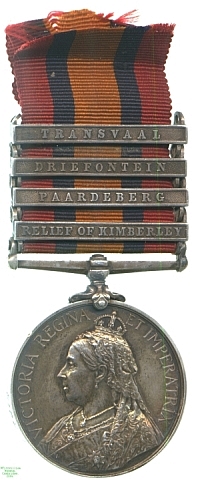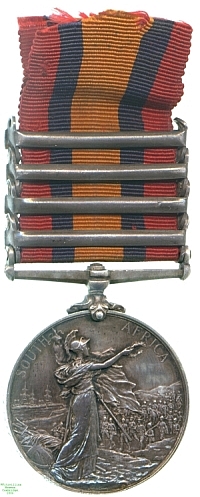
Obverse, a bust of Queen Victoria with veil

Reverse, Britannia in the foreground facing right holding a standard and waving a wreath over an army marching along the shore, with ships offshore in the background

Obverse, a bust of Queen Victoria with veil |

Reverse, Britannia in the foreground facing right holding a standard and waving a wreath over an army marching along the shore, with ships offshore in the background |
During the 1830s and 1840s several Dutch republics had been established outside the British Cape Colony in South Africa, among which were Transvaal and the Orange Free State, all now in modern South Africa. Transvaal was annexed briefly by the British but its independence re-established in the First Boer War.
In the 1880s however the discovery of vast gold reserves in Transvaal brought large numbers of foreign settlers, largely British, across the border, and an attempted coup at the instigation of Cecil Rhodes in 1895. Military escalation followed, negotiations failed and the two Boer republics, convinced that the British intended annexation, declared war in the Cape Colony in October 1899.
The immediate result was the siege of British troops in Ladysmith, Mafeking and Kimberley, while field forces attempting to come to their relief were defeated in several open battles by Boer contingents. Kimberley, the first town to be relieved, could open its gates only in mid-February; Mafeking, famously, had to hold out until May. A relief force sent to Ladysmith was roundly defeated by Louis Botha at Colenso in January 1900, and again at Val Krantz on 5 February. Engagements in this war came to involve very high Imperial casualties sacrificed to force a withdrawal on Boer units whose primary aim was to remain a fighting force, and one to which old-fashioned Imperial tactics of frontal assault in formation were `easy meat'. By such bloody battles, nonetheless, the Empire's troops rolled the Boer forces back into their own territory. These combats included a bitter close engagement at Driefontein on 10 March 1900, whose site has only recently been reinvestigated. After victory there, Imperial troops penned up a portion of the Boer forces in a siege at Paardeberg, which was captured by General Lord Horatio Kitchener, and Ladysmith was finally relieved on 15 February. The Boers were nonetheless not finally forced to a surrender until May 1902.
This medal was awarded to Corporal Wheeler W. White of the Army Service Corps, who was part of the force that fought at Driefontein, went on to Paardeberg and finally relieved Ladysmith, and who then apparently went on to serve with the forces clearing out guerillas in the Transvaal. His medal's inscription has been officially corrected. Also, the earliest issues of the medal indicate that the War was not expected to last as long as it did, as they bear the dates 1899-1900 in the reverse field. Very few were issued in this state, but a large number of the first issues show signs of the dates' erasure, often as in this case insufficiently thorough, so all-in-all the piece has suffered somewhat at the hands of the Royal Mint. Lester Watson acquired the medal at some point before 1928.